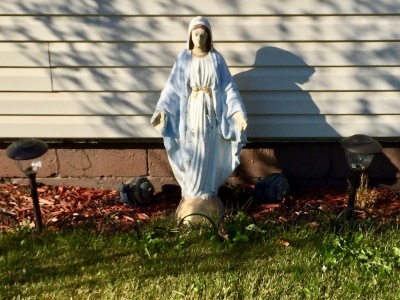
Going stag: Mary and uni-antlered deer on a front lawn in the Presston neighborhood of McKees Rocks.
You’ll not accidentally find yourself in Presston. No, those making the trip to the tiny residential neighborhood at the northernmost end of McKees Rocks either live there, are visiting someone who does, or–in the case of your particularly wayward author–are just dying to find out what’s on the other side of all those big factory buildings along the riverfront.
The journey to Presston–yes, that’s spelled correctly with two S’s–involves a circuitous route over the little bridge at Chartiers Creek, down River Avenue, past Lane Steel and Six Star Service, and through the McKees Rocks “bottoms” [not “flats” like everywhere else] with its rows of worker housing and glorious trio of onion-domed Russian and Ukrainian Orthodox churches*.
From there, one must locate the only point to breach the massive concrete base of the McKees Rocks Bridge on Helen Street, hang a left on George, and then straight down Nichol Ave. You’ll run parallel with train tracks on one side and see the kind of enormous industrial buildings that don’t really exist in the city proper (at least, not anymore) on the other. This giant footprint is currently home to McKees Rocks Fabrication and Penn Waste Systems, PVS Nolwood Chemicals and Cargill Salt.
Finally, tucked away at the end of this half-mile of corrugated steel, guard booths, and security fencing, is a pair of dead-end residential streets. Each is lined up and down with matching two-story wood frame double-houses. Behind you lie factory buildings and train tracks; ahead is brownfield and the Ohio River. You’ve ended up–the only way you possibly can–in Presston.
A historical plaque on the site informs us the neighborhood was built as worker housing by the Pressed Steel Car Company–which is presumably where it gets its name and double-S spelling. The uniform duplexes had been built by 1909 when there was a workers strike leading to the “‘Bloody Sunday Uprising’ where at least 11 people died.”
The marker goes on to state that the company sold the houses–we assume to private individuals–after Pressed Steel Car ceased operation in 1949. Like we saw at Aluminum City Terrace in New Kensington and Donora’s Cement City, things get a lot more interesting when the company lets go of control and people get do to do their own thing with the houses they own.
We don’t know what the houses looked like when they were sold off in 1949, but now, seventy years later, there’s been a predictable divergence in styles and updates, adaptations and repair. Aluminum siding has been added to all but a just a few of the wood houses, porches reconfigured into front rooms, a couple of the duplexes were merged into single, larger homes. There are a few empty spots where fire or neglect have claimed some of the old houses, but for the most part, almost every lot is full.
What really impressed this outsider is how Presston’s residents have gone nuts with yard decoration. The little space in front of each house may only be a hundred square feet or so–that’s just not enough real estate to warrant keeping up a grass lawn. In a neighborhood where everyone simply must know everyone else, it also seems unlikely either theft or vandalism is a problem.
At least that’s The Orbit’s hypothesis for why, house-for-house, Presston has an off-the-charts quantity of front yard ornamentation: tiny angels and garden gnomes, holiday displays and concrete statuary, repurposed toys and patriotic signs. It’s an exaggeration, but it feels as if nearly every one of Presston’s hundred-and-fifty-or-so little houses had stepped up to make a front-facing effort to greet the neighbors and express itself to the world.
… which brings us to Mary.
Yes, the quantity of holy mothers standing guard and blessed virgins decorating and protecting the front porches, steps, and sidewalks of Ohio and Orchard Streets is staggering. The über-pious residents of Bloomfield and South Oakland–not to mention McKees Rocks proper–likely put in extra hail Marys just to try to keep up with the blue-robed wave of tiny Presston.
Why, it kills a nebby blogger that between the ticking of the clock, a lack of connections, and the fear of getting a boot in the keister, he just couldn’t make it around to check out the alley-side view of these houses. Given the opportunity, we may have found just as many–or more–Marys holding court around back as they had pointing street-side.
Sigh. The thought of another dozen loose Marys–getting it done between the charcoal grill and patio set, next to the garden hose, or in the shadow of the tool shed–is almost too much to bear…almost.
To the good citizens of Presston: we’re hooked. We know your collection of street-facing Marys is only one small detail in the rich story of a neighborhood that doesn’t just have a unique spot on the map, but promises a fascinating history–complete with strikes and conflict, economic upheaval and population change, pressed steel cars and, yes, a whole lotta Mary.
If you’ll have us, we’d love to know more about that history. Give us a holler. Until then, color The Orbit impressed with Presston.
* In fairness–depending on which direction you’re coming from–one may skip these first steps by taking the Helen Street exit off the McKees Rocks Bridge. That wasn’t how we got to Presston, and it’s still one-way-in/one-way-out no matter how you get to Nichol Avenue.













Great story, I wouldn’t mind moving there. Distant relative lives there on Ohio St worked in Presston his whole live, love to hear trains and be near river.
LikeLike
Looking forward to see more pictures and stories, would like to get group together.
LikeLike